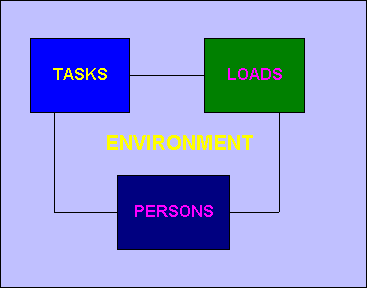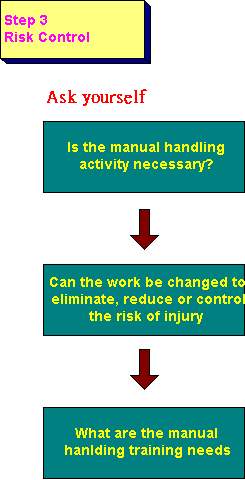Process in Preventing Manual Handling Injuries
-
The process of identifying factors in the work process which could result in a risk of manual handling injury.
-
Purpose : To identify and prioritize the jobs or tasks which require risk assessment.
-
When to do:
-
Where jobs or tasks involve manual handling
-
Where an employee has reported a manual handling hazard
-
Where an injury has occurred
-
-
The Process:
-
Analysis of injury records and incident reports.
-
Consultation with employees and supervisors.
-
Direct observation
-
The process of assessing all risk factors identified in the identification stage.
Purpose: To determine appropriate ways of dealing with the problem.
Consult with employees doing the manual handling tasks
2 stages:
-
Preliminary Assessment
-
Further Detailed Assessment
A Risk Assessment for Manual Handling Operation form (MH/AS)with a checklist is to be used while observing the tasks being done. There should be consultation with employees while compiling the checklist.
The four principal areas covered in risk assessment section relate to:

-
The workplace environment
-
The load handled
-
The task done; and
-
Characteristics of employees
The process of eliminating or reducing identified and assessed risk factors.

Purpose: To make the job or task safer for employees, and reduce the incidence of manual handling injuries.
When to do: After completing the risk assessment process.
What can be made:
-
Job re-design
-
Can include one or a combination of the following:
- Modify the object handled
- Modify the workplace layout
- Rearrange the flow of materials
- Use different actions, movements or forces
- Modify the task with mechanical assistance
- Modify the task with team lifting
-
-
Mechanical handling equipment
-
Provision of mechanical handling equipment, together with appropriate training in its use.
-
-
Training
-
Where job re-design or provision of mechanical handling equipment cannot reduce the risk, employees should receive specific training or education in how to carry out the manual handling task with least risk.
-
-
Administrative Controls
-
Other factors could have a bearing on the risk of manual handling. The following factors should also be considered:
- Employees' special needs. An employee's state of health or age may affect their risk of injury from a manual handling task.
- The provision of special clothing, including footwear and gloves, can reduce the risk of injury.
-

Short term vs. Long term measures*
Evaluation of the Controls
- Have the changes been correctly implemented?
- Are the changes causing further problems?
- Do they help reduce injuries?
*Short term: Short term control measures can be implemented immediately, while other measures requiring further planning or financial commitments, can be introduced in the longer term.